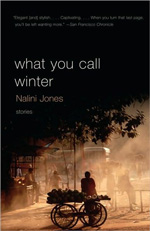
Nalini Jones' short story collection opens a door into an India you may never have encountered before. Yes, you will still encounter the saris, the curries, the streets full of rickshaws and bullocks, but this special world has another delicious flavor all its own. For one thing, her characters have names like Francis Almeida and Roddy D'Souza, somewhat mind-jangling at first, but not so strange for Catholic Indians, who were first converted by the Portuguese in the 16th century. Here we have people whose calendars are marked with Palm Sundays and Christmas Eves, who memorize Bible verses and say the rosary. These are not religious stories, but they are stories about people for whom religion is a cultural linchpin. And in this way, of course, they are quintessentially Indian.
The scope of the tales is small and powerfully intimate. All the characters spring from—or end up in—one small community called Santa Clara, near the Mumbai suburb of Santa Cruz. These are modern suburban Indians who take commuter trains or drive themselves to work, the comfortable middle class that produces the stream of educated Indians who travel to and from the United States, often settling abroad but returning to visit their homeland regularly, shaping both cultures as they are shaped by them.
Although each story stands alone, its characters and their experiences frequently overlap, just as they might in a real community over time. Marian Almeida, the little girl who returns home early from piano practice to disastrous results, is the sister of Jude, who appears in another story as a small child desperate to take part in family festivities. Jude appears in a third story as a secondary character, an adult who provides the voice of sanity in a family torn apart by disappointment, and Marian herself returns in a story that takes place in America, where she is uneasily raising her children. Her brother Simon—a haunting character reminiscent of Salinger's Seymour Glass—drifts through more than one story, before and after he is sent away to boarding school and is apparently lost to his family forever.
Other stories focus on the Almeida's neighbors, friends, relatives and their servants. The threads that connect these characters are so fine that they are easy to miss. And yet connected they are, even if only by a common uncle or employer, a marriage proposal or a card game. Thus we are invited into a virtual community whose history soon feels like our own.
This is a brilliant collection of evocative tales, told with simple clarity through the eyes of children,
adults and adolescents. They are so perfectly honed that the writing seems effortless, invisible,
allowing each story to enfold us and pull us in like life itself. Best of all, each one fulfills
the promise that the best stories invariably do; they highlight a moment of truth in the life of
a character, a pivotal point when everything comes into focus. They are gentle, touching, satisfying,
and most of all true.

Anchor, paperback, 9781400077953
